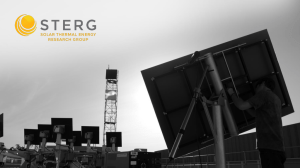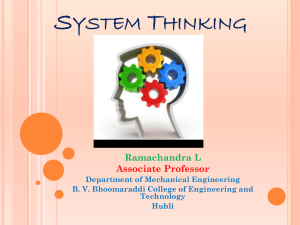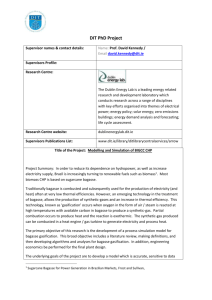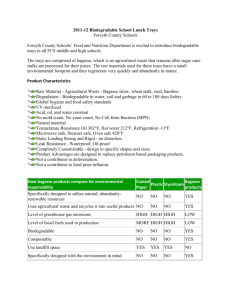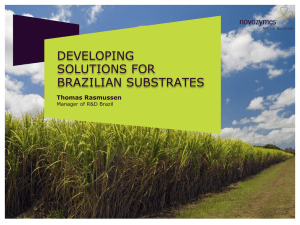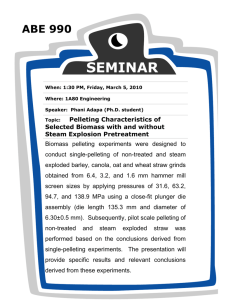Process modelling of sugar mill biomass to energy conversion processes... integration of pyrolysis
advertisement
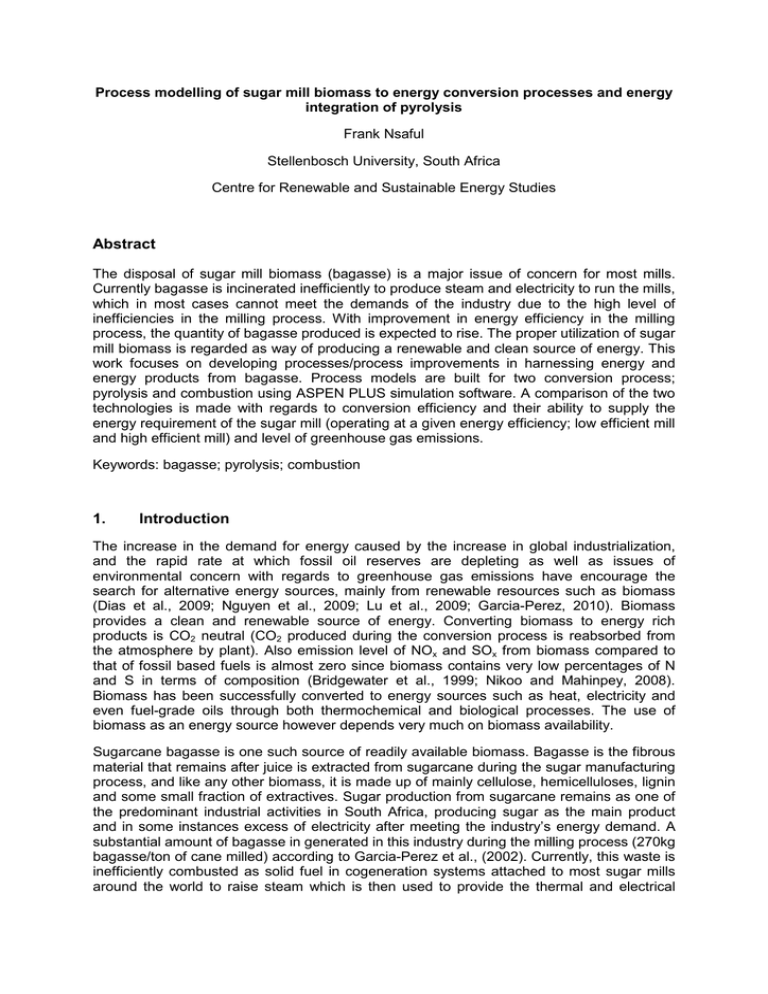
Process modelling of sugar mill biomass to energy conversion processes and energy integration of pyrolysis Frank Nsaful Stellenbosch University, South Africa Centre for Renewable and Sustainable Energy Studies Abstract The disposal of sugar mill biomass (bagasse) is a major issue of concern for most mills. Currently bagasse is incinerated inefficiently to produce steam and electricity to run the mills, which in most cases cannot meet the demands of the industry due to the high level of inefficiencies in the milling process. With improvement in energy efficiency in the milling process, the quantity of bagasse produced is expected to rise. The proper utilization of sugar mill biomass is regarded as way of producing a renewable and clean source of energy. This work focuses on developing processes/process improvements in harnessing energy and energy products from bagasse. Process models are built for two conversion process; pyrolysis and combustion using ASPEN PLUS simulation software. A comparison of the two technologies is made with regards to conversion efficiency and their ability to supply the energy requirement of the sugar mill (operating at a given energy efficiency; low efficient mill and high efficient mill) and level of greenhouse gas emissions. Keywords: bagasse; pyrolysis; combustion 1. Introduction The increase in the demand for energy caused by the increase in global industrialization, and the rapid rate at which fossil oil reserves are depleting as well as issues of environmental concern with regards to greenhouse gas emissions have encourage the search for alternative energy sources, mainly from renewable resources such as biomass (Dias et al., 2009; Nguyen et al., 2009; Lu et al., 2009; Garcia-Perez, 2010). Biomass provides a clean and renewable source of energy. Converting biomass to energy rich products is CO2 neutral (CO2 produced during the conversion process is reabsorbed from the atmosphere by plant). Also emission level of NOx and SOx from biomass compared to that of fossil based fuels is almost zero since biomass contains very low percentages of N and S in terms of composition (Bridgewater et al., 1999; Nikoo and Mahinpey, 2008). Biomass has been successfully converted to energy sources such as heat, electricity and even fuel-grade oils through both thermochemical and biological processes. The use of biomass as an energy source however depends very much on biomass availability. Sugarcane bagasse is one such source of readily available biomass. Bagasse is the fibrous material that remains after juice is extracted from sugarcane during the sugar manufacturing process, and like any other biomass, it is made up of mainly cellulose, hemicelluloses, lignin and some small fraction of extractives. Sugar production from sugarcane remains as one of the predominant industrial activities in South Africa, producing sugar as the main product and in some instances excess of electricity after meeting the industry’s energy demand. A substantial amount of bagasse in generated in this industry during the milling process (270kg bagasse/ton of cane milled) according to Garcia-Perez et al., (2002). Currently, this waste is inefficiently combusted as solid fuel in cogeneration systems attached to most sugar mills around the world to raise steam which is then used to provide the thermal and electrical energy demand of the industry (Mbhowa, 2003; Pippo et al., 2007). Virtually less or no surplus bagasse is made available due to the energy intensive nature of the sugar manufacturing process and the high levels of inefficiencies in both the cogeneration systems and the production process with regards to the use of energy (Ensinas and Nebra, 2007). Given the rapidly changing market for sugar and the instability and uncertainties in the price of sugar, it has become apparently important for sugar factories to introduce some form of product diversification in the industry (Banerjee et al., 2003). The production of valuable products from bagasse is one way in which sugar factories can bring in added benefits. Bagasse has several energy potentials which have not yet been exploited by the sugar industry (Pippo et al., 2007). Among the diversity that can be introduced into the sugar industry are the generation of excess power through improvement in efficiency of biomass combustion process and the production of fuel and speciality chemicals from bagasse. Exploring the potential of bagasse however requires the availability of sufficient amount of bagasse and this in turn calls for improvement in process efficiencies and the proper use of energy in sugar mills. Energy integration in the sugar industry is identified as a way of minimising the waste of energy and ensuring the proper use of energy (Ensinas and Nebra, 2007; Ensinas et al., 2009). The implementation of energy integration measures will thus make sufficient bagasse available, since the thermal energy demand of the mill will be reduced drastically, implying less bagasse needed for steam generation. However, storing large quantities of bagasse for future use in financial terms is not beneficial to the sugar industry. Bagasse has low bulk density (Bridgewater et al., 1999; Pippo et al., 2007; Pippo et al., 2009), hence requiring large volume for storage, which is very expensive. Moreover, stockpiling bagasse and other sugarcane residues poses problem of environmental threat to sugar mills and their surroundings because bagasse is self combustible and may spontaneously combust if stockpiled for longer periods (Lavaracka, et al., 2002; Pippo et al., 2007). This means that it (bagasse) be readily converted to valuable energy sources such as electricity in highly efficient cogeneration systems for sale to the grid as is been done in Mauritius and Reunion (Mbhowa, 2003). The one-time use of bagasse implies that the sugar mills will have to depend on fossil based fuel for energy generation during off-season, and to avoid this, the need arises for the search for alternative ways of converting bagasse and other sugarcane agro-industry waste into products that can easily be stored for future use. One way of converting bagasse into storable product is by the use of pyrolysis. Generating energy products from waste biomass in sugarcane harvesting/milling through pyrolysis has become economical and environmentally interesting. Pyrolysis, a thermochemical process, has been used to convert biomass such as bagasse into high energy dense products (bio-oil and char). Unlike other thermochemical processes such as gasification and combustion where syngas and heat generated respectively have to be used readily on site, the products of pyrolysis can be stored and used later when the need arises. The bio-oil produced can be used for electricity production during both in-season and off-season hence ensuring all year round electricity production of which surplus can be offered for sale to the grid to generate extra income for the sugar industry. Also char can be upgraded to activated carbon which can be used in the sugar refinery process to remove colour. Char can also be use as fertilizer on sugarcane plantations. Apart from these benefits, pyrolysis also has the ability to supply the thermal and electrical energy needed for the sugarcane milling/sugar production process especially in the case of fast pyrolysis. Due to the high temperatures at which the technology of fast pyrolysis operates, as much energy as possible can be harnessed in the form of high pressure steam during pyrolysis products recovery which can then be used to provide the thermal and electrical energy duty of the sugar mill plant. This work therefore seeks to develop process models for the efficient conversion of sugar mill biomass to energy (steam and electricity) with emphasis on combustion and pyrolysis and assessing the efficiency of the two processes. 2. Proposed model/conceptual method The proposed model uses Aspen Plus simulation software to generate mass and energy balances for both the pyrolysis and combustion technologies. The program has standard unit operation blocks like reactors, pumps, tanks, etc, which models actual processes occurring in a typical plant. It also has a comprehensive component database, which contains the physical properties of several pure components. A process is simulated in Aspen Plus by first building a flowsheet representation of the process and then specifying the operating parameters of unit operation blocks as well as the flow of heat, material and work streams. Material, energy and equilibrium balances are then solved in a sequential order by the program using mathematical algorithms until there is convergence. 2.1 Sugar mill biomass The biomass considered in this model is sugarcane bagasse. Bagasse is the fibrous remains of sugarcane stalks after crushing and extraction of juice. Like any other biomass, it is composed of cellulose, hemicelluloses and lignin. It is estimated that approximately 270 kg of bagasse (50% humidity) is produced per ton of sugarcane processed (Garcia-Perez et al., 2002) or 1.25 kg of bagasse is produced per kilogram of sugar produced (Botha and Von Blottnitz, 2006; Singh et al., 2007). Bagasse as feed has varying composition and heating values. Its characteristic property depends mainly on the climate, type of soil on which cane was grown, cane variety, harvesting method, amount of cane washing and the efficiency of the milling plant (Janghathaikul and Gheewala, 2004). The High Heating Value (HHV) and the Low Heating Value (LHV) of bagasse (at 50% moisture) are 9.55MJ/kg and 7.67MJ/kg respectively (Mbohwa, 2003). Oven dry bagasse has HHV of about 18 MJ/kg (Garcia-Perez et al., 2002). 2.2 Estimation of biomass availability and plant size A 300 tons of cane/hr (wet cane as received at the mill) capacity mill is chosen as the basis for the work. This value is an average figure for 14 mills in South Africa which was calculated based on the South African Sugar Association (SASA) (Sugar Outlook, 2009) production figure for the 2008/09 milling season. From this figure, 81 tons/hr of bagasse (at 50% moisture) is obtained assuming that 270kg of bagasse is produced per ton of cane crushed (Garcia-Perez, et al., 2002). Therefore, 81tons/hr of bagasse is set as the throughput capacity of the biomass conversion processes. 2.3 Simulation development To effectively simulate the process for the conversion of bagasse to energy and energy products, it is important to know it composition. Good data on bagasse compositional analysis is thus very vital. Table 1 shows the values adopted for this work. These are average values computed from experimental result obtained from bagasse compositional analysis work done at Stellenbosch University (Hugo, 2010) and compares very well with values reported in literature. Table 1 - Bagasse composition Component This work Moisture Lignin, (dry basis) Cellulose, (dry basis) Extractives, (dry basis) Ash, (dry basis) Hemicelluloses, (dry basis) Value, % Garcia-Perez et al, (2002) 50 25.5 40.6 7.5 3.6 22.8 50 20-27 35-50 8-12 (for total extractive and ash) 20-30 Due to the complex nature of bagasse, the physical property data for most of these components cannot be found in the Aspen Plus property databases. Properties for these components were therefore taken from the in-house Aspen Plus property database developed by the National Renewable Energy Laboratory (NREL) in the United State, and incorporated into the standard Aspen Plus database. Lignin, cellulose, extractives, and hemicellulose were the components taken from the NREL database. The hemicellulose component was further split into xylan, mannan, galactan and arabinan to simplify the model. Combustion model description The model as built in AspenPlus is based on the Rankine cycle of a Combined Heat and Power (CHP) plant which is currently the most predominantly used cogeneration system in sugar mills. It consists mainly of the biomass combustor; steam generator (boiler) and turboalternator (see Fig. 1). LP steam Bagasse Biomass combustor Air Cleaned hot gases Steam generator/boiler HP steam Feedwater Turboalternator Electricity Figure 1 – Schematic representation of the combustion process. In this process, fuel (bagasse at 50% moisture) and combustion air are fed to the biomass combustor. Hot combustion gasses generated after combustion are cleaned to remove ash and particulate matter and then sent to the boiler for steam production. The combustor is modelled as a stoichiometric reactor (RSTOIC) in AspenPlus and the combustion reactions are generated by the program. In addition, the reactor is assumed to operate at adiabatic conditions, in which case the net heat duty of the reactor is set to zero in AspenPlus. This ensures that all the combustion energy is supplied by the only the bagasse. Combustion air is preheated with fluegas in the air preheater to raise its temperature to 250oC prior to been fed to the combustor. Air is supplied in excess to ensure complete combustion and also to make sure that the percentage volume of oxygen in the fluegas meets environmental standards. Cleaned hot combustion gasses from the combustor are sent to the boiler from which heat is recovered to raise high pressure steam (HP Steam). The boiler is modelled as a series of three heat exchangers in Aspen Plus. Feedwater enters the first exchanger (economiser) where its temperature is raised to the just below the saturation temperature and then sent to the second exchanger (evaporator) to produce saturated steam. The third exchanger raises the temperature of the saturated steam to HP steam at superheat conditions, depending on the degree of superheat set in the program. The flow of water is controlled by setting a ‘design specification’ feature in the Aspen Plus program. This is done to ensure that HP steam leaving the boiler meets certain conditions of superheat. All heat for the steam generation is supplied by the hot combustion gasses. HP steam from the boiler is expanded in a turbo-alternator; back-Pressure Steam Turbine (BPST) or Condensing Extraction Steam Turbine (CEST), depending on the pressure of the steam, to produce electricity and Low Pressure steam (LP steam) for the sugar mill. In this model, the turbine is modelled as an isentropic turbine in with an isentropic efficiency of 85% and a generator efficiency of 98%. Also this model assumes that all prime movers in the sugar mill are run by electrical motors; hence all the HP steam generated by the boiler is directed to the turbine. Pyrolysis model description The flow diagram of the pyrolysis process is shown in Figure 2. Only fast pyrolysis is considered in this current model. The process design is based on a fast pyrolysis process developed by Leibrandt, 2010, which is modified and updated using experimental data for sugarcane bagasse fast pyrolysis obtained from Stellenbosch University (Hugo, 2010). The processing steps consist of pretreatment, pyrolysis, condensation and oil recovery, heat recovery and a steam cycle to produce heat and electricity. The pretreatment section involves the drying of bagasse feedstock from 50% moisture as received to about 10% moisture content using preheated process air, this is then followed by grinding to reduce the particle size to about 2mm, which the recommended particle size for fast pyrolysis. Drying of the feedstock is vital as any moisture present in the feed will end up in the bio-oil produced thereby affecting its heating value and quality (Bridgwater and Peacocke, 1999; Ringer et al., 2006). The dried material is fed to the pyrolysis section where pyrolysis reactions take place (at 500oC and 1atm pressure in a fluidised bed reactor) yielding char, condensable biocrude components and non condensable gases. Char is separated from the condensable and noncondensable gases using cyclone which follows directly after the reactor and a part of the char is combusted together with the off-gas from the reactor to supply the energy needed to run the pyrolysis process. Some of the reactor gas is recycled to act as a fluidising gas while also heating the reactor feed. Because of the non-equilibrium nature of the pyrolysis process, the reactor is modelled as a yield reactor in AspenPlus. In this way, the output of the pyrolysis reactor is set using components yields obtained from the measured experimental data. In the condensation and oil recovery section, gas product from the cyclone is cooled in a series of condensers. Heat is recovered from the first condenser to generate steam for the steam turbine cycle, while the second condenser provides energy to pre-heat the air used for drying of the bagasse. This is followed by an oil scrubber, which recovers 80% of the biocrude components to the liquid phase. The oil recovery is further enhanced by feeding a recycle gas stream from the last oil recovery flash drum to the oil scrubber. An electrostatic precipitator is used to recover 99.9% of the biocrude components lost to the scrubber vapour stream. The oil product is sent to the product recovery section where a small portion is recycled to the scrubber and the rest is stored as a product. In the combustion and steam turbine section, any non-condensable gas required as fluidising medium by the pyrolysis section is removed, while the remaining off-gas is sent to a combustor for combustion. The combustor is modelled as a stoichiometric reactor and AspenPlus calculates the combustion reactions. Complete combustion is assumed in this model. Heat generated during combustion is used to supply the energy needs of the pyrolysis reactor, and the product gas is cooled in a series of condensers to recover heat which is used to raise steam for the steam cycle. This steam is mixed with the steam raised during quenching and fed to a steam turbine that generates electricity for use in the process at an isentropic efficiency of 85%. Heated dryer air Char product Process air Pretreatment Bagasse • Grinding • Drying Pyrolysis Biocrude Char Process power Process steam Recycled gas Combustor/Steam turbine Export electricity • Condensation • Oil scrubber • Electrostatic precipitator Process water Product recovery Bio-oil product Figure 2 – Schematic representation of the pyrolysis process. 3. Research method To determine the capacity of the two technologies (combustion and pyrolysis) in supplying the steam and electricity demands of the sugar mill, three scenarios of the sugar mill operating at different process energy efficiencies are considered in this conceptual design. The base case is a sugar mill operating at 62% steam on cane. The sugar mill operating at 52% and 45% steam on cane are the other cases considered. Steam on cane refers to the quantity of LP steam required for heating purposes in the sugar milling operation and it is the measure of the level of efficiency used in the sugar industry. The higher the percentage steam on cane, the less efficient is the milling process. 4. Results/discussion Results for both combustion and pyrolysis technologies are shown for each of the three scenarios. It must be emphasized that these are only preliminary results and does not take into account the optimisation of the conversion processes, which will done later on as part of the study. Table 2 - Combustion results Type of turbo alternator % steam on cane Mill LP steam requirement, ton/hr HP steam generated, ton/hr Electricity generated, MW e BPST (30bar, o 400 C) BPST (30bar, o 400 C) CEST (63bar, o 520 C) 62 186 160 20 52 156 160 20 45 135 160 47 BPST (30bar, o 400 C) BPST (30bar, o 400 C) CEST (63bar, o 520 C) 62 186 145 16 52 156 145 16 45 135 145 33 Table 3 - Pyrolysis results Type of turbo alternator % steam on cane Mill LP steam requirement, ton/hr HP steam generated, ton/hr Electricity generated, MW e From table 2 above, it is clear that the percentage steam on cane does have an effect on the electricity generation. For 62% steam on cane, the model predicts that the available biomass (bagasse) cannot meet the demand of the mill, thus requiring the input of external source of fuel. The steam produced just meets the demand for the 52% steam on cane scenario, leaving no extra for further electricity generation. Due to the low steam demand of the 45% steam on scenario, there is extra bagasse available. This model considers the combustion of all the available bagasse hence generating the same quantity of steam as in the other scenarios but a high pressure. The use of the CEST system allows for the extraction of the required LP steam for the mill at 2 bar pressure and the remaining steam further condensed to below atmospheric pressure (0.6 bar) for extra electricity production. The current model assumes that electrical motors are used to drive all prime movers in the sugar mill implying that all HP steam generated goes directly to the turbo-alternator system, but this is not the case in most mills today. When this is considered, the electricity generation in all three scenarios will be reduced, thereby even making matters worse for the low efficient mill, as it will be able to also meet its electricity requirements. The pyrolysis results (Table 3) indicates that the technology is more suitable for low steam consumption sugar mills. Because the pyrolysis process has its own electricity requirement, the power available for use by the sugar mill is small as compared to the combustion case. However, it must be noted that the process does also produces other energy products (biooil and char) which can be further processed to generate more electricity. 5. Conclusion and recommendations Preliminary Aspen Plus process models have been built to convert sugar mill biomass (bagasse) into energy and energy products. The results obtained indicate that the proper use of energy (steam) by sugar mills in the cane mill process is a key to recovering more value from bagasse. It is therefore recommend that sugar mills put in place efficient energy integration measures to cut down on their energy. The models developed are only preliminary models and therefore need to be optimised. References 1. Botha, T. and Blottnitz, H.V. (2006). “A comparison of the environmental benefits of bagasse-derived electricity and fuel ethanol on a life-cycle basis.” Energy Policy 34: 2654–2661. 2. Bridgewater, A.V.; Peacock, G.V.C. (1999). “Fast Pyrolysis Process for Biomass.” Sustainable and Renewable Energy Reviews, 4: 1-73. 3. Dias, O. S. M., Ensinas, A. V., Nebra, S. A., Filho, R. M., Rossell, C. E. V. and Maciel M. R. W. (2009). “Production of bioethanol and other bio-based materials from sugarcane bagasse: Integration to conventional bioethanol production process.” Chemical Enginering Research and Development, 87: 1206-1216 4. Ensinas A. V. Nebra, S.A., Lozano, M.A. and Serra, L.M. (2007). “Analysis of process steam demand reduction and electricity generation in sugar and ethanol production from sugarcane.” Journal of Energy Conversion and Management, 48: 2978-2987 5. Ensinas, A.V., Modesto, M., Nebra, S.A. and Serra L. (2009). “Reduction of irreversibility generation in sugar and ethanol production from sugarcane.” Energy, 34: 680-688. 6. Garcia-Perez, M., Shen, J., Wang, X.S. and Li, Chun-Zhu. (2010). “Production and fuel properties of fast pyrolysis oil/bio-diesel blends.” Fuel Process Technology, 91: 296-305 7. Garcia-Perez, M.; Chaala, A.; Roy, C. (2002) “Vacuum pyrolysis of sugarcane bagasse.” Fuel, 81: 893-907 8. Hugo, T (2010). “Pyrolysis of South African sugarcane bagasse.” MSc. Thesis submitted to Stellenbosch University, July 2010. 9. Janghathaikul, D., and Gheewala, S.H. (2004). “Bagasse - a sustainable energy resource from the sugar mills.” The Joint International Conference on Sustainable Energy and Environment (SEE), 1-3 December, Hua Hin,Thailand. 10. Jenkins, B.M., Baxter, L.L., Miles Jr., T.R., Miles, T.R. (1998). “Combustion properties of biomass.” Fuel Processing Technology 54 (1–3): 17– 46. 11. Lavaracka, B., Griffin, G., & Rodmanc, D. (2002). “The acid hydrolysis of sugarcane bagasse hemicellulose to produce xylose,arabinose,glucose and other products.” Biomass and Bioenergy , 23:367-380. 12. Leibbrandt, N.H (2010). “Techno-economic study for sugarcane bagasse to liquid fuels in South Africa: A comparison between biological and thermochemical process routes.” PHd dissertation presented to Stellenbosch University, March 2010. 13. Lu Q., Wen-Zhi, L., and Xi-Feng, Z. (2009). “Overview of fuel properties of fast pyrolysis oils.” Energy Conversion and Management, 50: 1376-1383 14. Mbohwa C. (2003). “Bagasse energy cogeneartion potential in the Zimbabwean sugar industry.” Renewable energy, 28: 191-204. 15. Nguyen, T. T., Hermansen, J.E., Sagissaka, M. (2009). “Fossil energy potential of sugar cane bio-energy systems.” Applied Energy, 86: s133-s139. 16. Nikoo, M.B, Mahinpey, N.(2008). “Simulation of biomass gasification in fluidized bed reactor using ASPEN PLUS.” Biomass and Energy, 32: 1245-1254. 17. Pippo, A.W., Luengo, C.A, Felfli, F.F, Garzone, P. and Cornacchia, G. (2009). “Energy recovery from sugarcane biomass residues: Challenges and opportunities of bio-oil production in the light of second generation biofuels.” Journal of Renewable and Sustainable Energy, 1, 063102. 18. Ringer, M., Putsche, V., and Scahill, J. (2006). “Large-Scale pyrolysis oil production: A technology assessment and economic analysis.” National Renewable Energy Laboratory ,Technical report, NREL/TP-510-37779, November,2006 19. Singh, S.P., Asthana, R.K. and Singh A.P., (2007). “Prospect of sugarcane milling waste utilization for hydrogen production in India.” Energy Policy, 35: 4164-4168. 20. Sugar Outlook (April,2009). [online], http://www.agrimark.co.za/productcs/downloads/sugar_industry-apr2009.pdf . Accessed -7th Oct., 2010.
